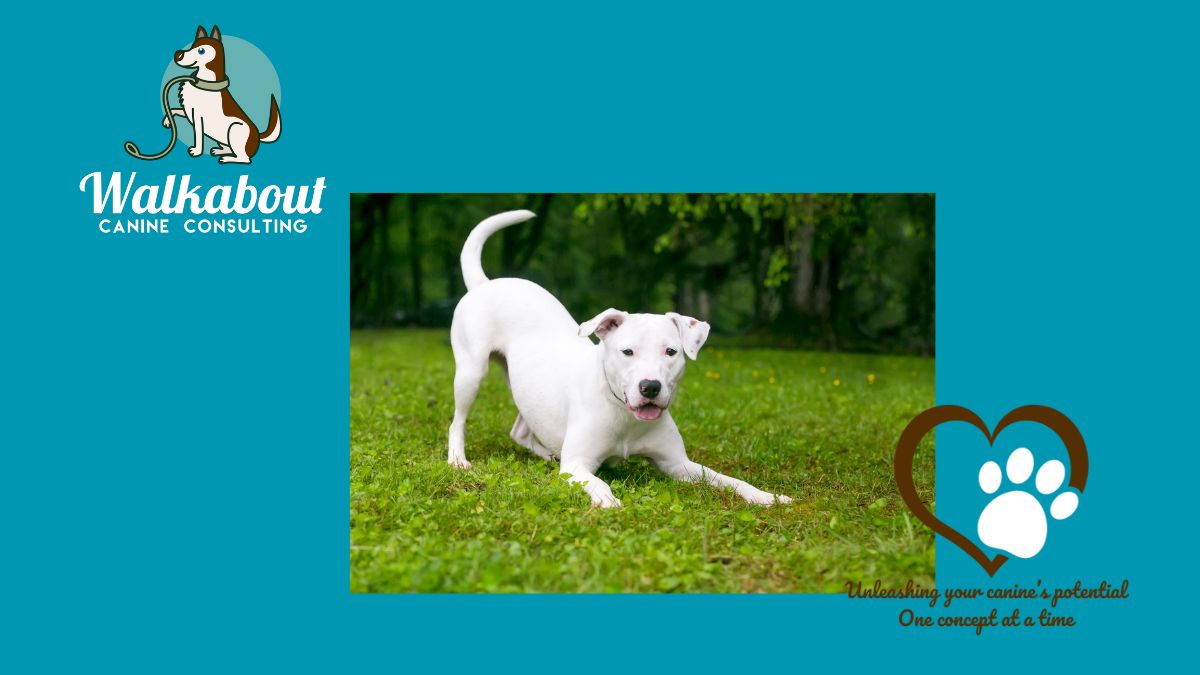Positive Dog Training & Behaviour Blog | Walkabout Canine Consulting
Unleashing your dogs potential, one concept at a time
Teaching your dog to Bow

Is it a Trick or more...
Teach Your Dog the “Bow” Trick: A Fun Stretch for Body and Mind
Why is Bowing Beneficial for Your Dog?
Dogs naturally perform a “bow” in their daily routines and social interactions. Teaching this trick taps into their instincts while offering several benefits:
- Social Behaviour: Bowing is often a dog’s way of saying, “Let’s play!” Reinforcing this action builds a fun, friendly gesture that dogs can use to engage with other dogs or people.
- Physical Fitness: The bow stretch targets hip flexors and lower back muscles, promoting healthy movement and flexibility. This makes it a great exercise for dogs of all ages, from active puppies to seniors with arthritis.
- Joint Health and Mobility: Regularly practicing the bow can help reduce joint stiffness, especially beneficial for dogs with arthritis, by increasing range of motion and relieving pressure on the spine and hips.
Step-by-Step Guide to Teaching the Bow
- Setting Up: Choose a quiet, calm space for this exercise.
- Use a Treat to Lure:
- Start with a treat in your hand, letting your dog sniff it.
- Slowly move the treat toward the ground to bring their head down, guiding them into a bowing posture.
- Tip: Keep the treat just close enough to encourage their front paws to extend while keeping their rear up.
- Mark the Movement and Reward:
As soon as your dog’s chest begins to lower, say a marking word like “Yes!” and reward them with the treat.- Practise marking and rewarding several times to reinforce the movement.
- Introduce the Cue:
- Once your dog consistently follows the lure, start using a verbal cue like “Bow” just before they move into the stretch.
- Over time, they’ll associate the word with the action.
- Build Duration Gradually:
- Aim for 7–10 repetitions of this stretch each session, gradually increasing the hold time. This strengthens your dog’s muscles and improves flexibility safely.
- Practice in Short Bursts:
- End each session on a positive note to keep your dog excited to learn and practice again.
Trainer Tips for the Bow Trick
- Keep It Fun: Dogs respond well to positive reinforcement, so keep the atmosphere upbeat with plenty of praise and treats.
- Slow and Steady: Start with brief stretches and gradually work up to longer holds to build flexibility over time.
- Consistency is Key: Practise the bow daily, especially when your dog is relaxed and more likely to engage. Consistent practice helps maintain muscle flexibility and joint health.
In Summary
Teaching the bow trick is more than just a fun game – it’s a fantastic stretch with lasting benefits:
- Increased Flexibility: Promotes healthy movement in the hips, back, and legs.
- Enhanced Mobility: Improves muscle conditioning for active lifestyles.
- Joint Health Support: Relieves arthritis discomfort and maintains ease of movement.
With patience and regular practice, the bow becomes a positive, playful addition to your dog’s routine, benefiting their mind and body!
Categories: : canine conditioning, dog behaviour, dog fitness, dog training, dog trick, teaching dogs
 Sylvia Koczerzuk Koczerzuk
Sylvia Koczerzuk Koczerzuk 
